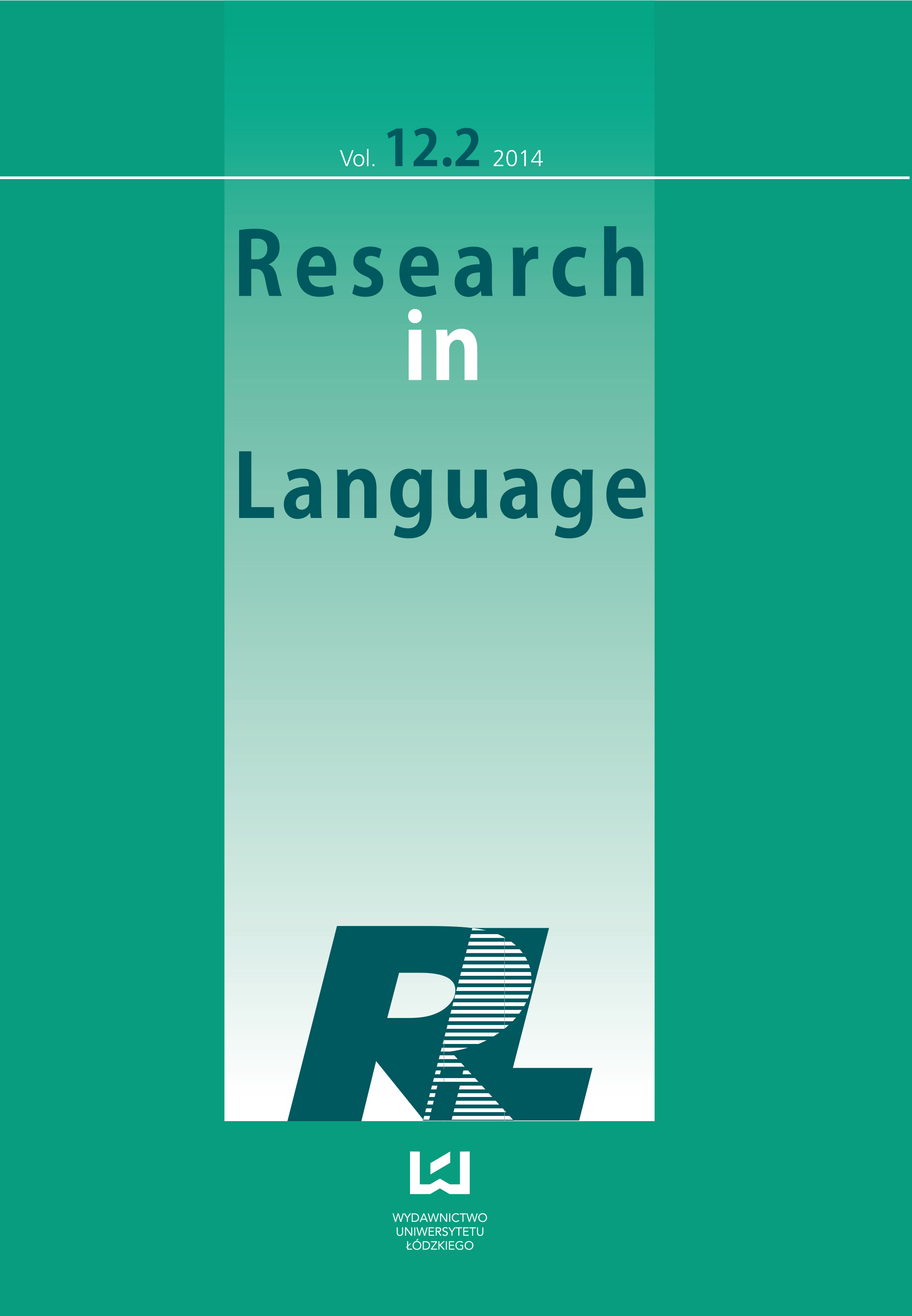Unstressed Vowels in German Learner English: An Instrumental Study
DOI:
https://doi.org/10.2478/rela-2014-0001Keywords:
vowel reduction, acoustic analysis, SLA, L1 German, L2 EnglishAbstract
This study investigates the production of vowels in unstressed syllables by advanced German learners of English in comparison with native speakers of Standard Southern British English. Two acoustic properties were measured: duration and formant structure. The results indicate that duration of unstressed vowels is similar in the two groups, though there is some variation depending on the phonetic context. In terms of formant structure, learners produce slightly higher F1 and considerably lower F2, the difference in F2 being statistically significant for each learner. Formant values varied as a function of context and orthographic representation of the vowel.
References
Abercrombie, D. 1967. Elements of general phonetics. Edinburgh: Edinburgh University Press.
Google Scholar
Aoyama, K. and S. Guion. 2007. Prosody in second language acquisition: Acoustic analyses of duration and F0 range. In M. Munro and O. Bohn (eds) Language experience in second language speech learning. Amsterdam: Benjamins. 281-297.
Google Scholar
Barry, W. 2007. Rhythm as an L2 problem: How prosodic is it? In J. Trouvain and U. Gut (eds) Non-native prosody: phonetic description and teaching practice. Berlin: Mouton de Gruyter. 97- 120.
Google Scholar
Broselow, E. and Y. Kang. 2013. Phonology and speech. In J. Herschensohnand M. Young-Scholten (eds) The Cambridge handbook of SLA. Cambridge: CUP. 529-553.
Google Scholar
Crystal, D. 2008. A dictionary of linguistics and phonetics. Malden: Blackwell.
Google Scholar
Dauer, R. 1983. Stress-timing and syllable-timing reanalysed. Journal of Phonetics 11: 51-62.
Google Scholar
Delattre, P. 1981. An acoustic and articulatory study of vowel reduction in four languages. In P. Delattre (ed) Studies in comparative phonetics. Heidelberg: Julius Groos. 63-93.
Google Scholar
Dellwo, V. and P. Wagner. 2003. Relations between language rhythm and speech rate. Proceedings of the 15th ICPhS, Barcelona, Spain. 471-474.
Google Scholar
Di Paolo, M., Yaeger-Dror, M. and A. Beckford Wassink. 2011. Analyzing vowels. In M. Di Paolo and M. Yaeger-Dror (eds) Sociophonetics. A student’s guide. New York: Routledge. 87-106.
Google Scholar
Dretzke, B. 2006. Ausspracheschulung im Fremd-sprachenunterricht. In U. Jung (ed) Praktische Handreichung für Fremdsprachenlehrer. Frankfurt: Peter Lang. 132-140.
Google Scholar
Flege, J. and O. Bohn. 1989. An instrumental study of vowel reduction and stress placement in Spanish-accented English. Studies in Second Language Acquisition 11: 35-62.
Google Scholar
Fox, J. 2013. Package ‘car’. R-package version 2.0-17. http://cran.r-project.org/web/packages/car/car.pdf
Google Scholar
Ghazali, S. and N. Bouchhioua. 2003. The learning of English prosodic structures by speakers of Tunisian Arabic: word stress and weak forms. Proceedings of the 15th ICPhS, Barcelona, Spain. 961-964.
Google Scholar
Gibbon, D. and U. Gut. 2001. Measuring speech rhythm. Proceedings of Eurospeech, Aalborg, Denmark. 91-94.
Google Scholar
Giegerich, H.J. 1992. English Phonology. Cambridge: Cambridge University Press.
Google Scholar
Gut, U. 2003. Non-native speech rhythm in German. Proceedings of the 15th ICPhS, Barcelona, Spain. 2437-2440.
Google Scholar
Gut, U. 2006. Unstressed vowels in non-native German, Speech Prosody 2006. Proceedings of the 3rd International Conference on Speech Prosody, eds. R. Hoffmann and H. Mixdorff. Dresden, Germany.
Google Scholar
Gut, U. 2009. Non-native speech. A corpus-based analysis of phonological and phonetic properties of L2 English and German. Frankfurt: Peter Lang.
Google Scholar
Kaltenbacher, E. 1998. Zum Sprachrhythmus des Deutschen und seinem Erwerb. In H. Wegener (ed) Eine zweite Sprache lernen. Tübingen: Narr. 21-38.
Google Scholar
Kendall, T. and E.R. Thomas. 2013. Package ‘vowels’. R-package version 1.2. http://ncslaap.lib.ncsu.edu/tools/norm/
Google Scholar
Kohler, J. 1995. Einführung in die Phonetik des Deutschen. Berlin: Erich Schmidt Verlag.
Google Scholar
Lee, B., Guion, S.B. and T. Harada. 2006. Acoustic analysis of the production of unstressed English vowels by early and late Korean and Japanese bilinguals. Studies in Second Language Acquisition 28(3): 487-513.
Google Scholar
Low, E.-L. and E. Grabe. 1995. Prosodic patterns in Singapore English. Proceedings of the 13th ICPhS. 636-639.
Google Scholar
Major, R. 2001. Foreign accent: The ontogeny and phylogeny of second language phonology. Mahwah: Erlbaum.
Google Scholar
Major, R. 2008. Transfer in second language phonology: A review. In J. Hansen Edwards and M. Zampini (eds) Phonology and second language acquisition. Amsterdam: Benjamins. 63-94.
Google Scholar
Ordin, M., Polyanskaya, L. and C. Ulbrich. 2011. Acquisition of timing patterns in second language. Proceedings of INTERSPEECH 2011, 1129-1132.
Google Scholar
Parkes, G. 2001. The Mistakes Clinic for German-speaking Learners of English. Southampton: Englang.
Google Scholar
Pascoe, G. 1996. Pronunciation Analysis and Teaching. In W. Barry and A. Addison (eds) Phonus 2. Saarbrücken: Institut für Phonetik. 109-122.
Google Scholar
Peterson, G.E. and H.E. Barney. 1952. Control methods used in a study of vowels. Journal of the Acoustical Society of America 24: 175-184.
Google Scholar
Pike, K.L. 1945. The intonation of American English. Ann Arbor: Michigan University Press.
Google Scholar
Porzuczek, A. 2010. The weak forms of TO in the pronunciation of Polish learners of English. In E. Waniek-Klimczak (ed) Issues in Accents of English 2: Variability and norm, ed.. Newcastle upon Tyne: Cambridge Scholars Publishing. 309-322.
Google Scholar
Ramus, F., Nespor, M. and J. Mehler. 1999. Correlates of linguistic rhythm in the speech signal. Cognition 73: 265-292.
Google Scholar
Roach, P. 1982. On the distinction between ‘stress-timed’ and ‘syllable-timed’ languages. In D. Crystal (ed) Linguistic controversies. Essays in linguistic theory and practice. London: Arnold. 73-79.
Google Scholar
Traunmüller, H. 1997. Auditory scales of frequency representation. http://www.ling.su.se/staff/hartmut/bark
Google Scholar
Wesener, T. 1999. The phonetics of function words in German spontaneous speech. In K. Kohler (ed) Phrase-level phonetics and phonology. Kiel: Universität Kiel. 327-377.
Google Scholar
Wilcox, R. 2012. Modern statistics for the social and behavioral sciences. Boca Raton: CRC Press.
Google Scholar
Downloads
Published
How to Cite
Issue
Section
License

This work is licensed under a Creative Commons Attribution-NonCommercial-NoDerivatives 4.0 International License.










